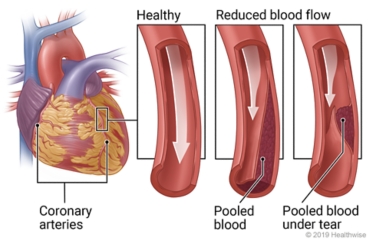
What is it?
A spontaneous coronary artery dissection (SCAD) is a condition that may cause a heart attack. A heart attack occurs when one or more of the coronary arteries is blocked. The coronary arteries supply the heart with oxygen-rich blood. If the heart does not get enough oxygen-rich blood, part of the heart starts to die.
The walls of blood vessels are made up of layers. With a SCAD, blood gets in between the layers of a coronary artery wall. This might be from a tear in the wall. But it might not be clear why the blood pools there. The pooled blood forms a bulge that narrows the artery. This blocks blood from reaching the heart.
SCAD occurs most often in young women. It usually happens without warning.
Most heart attacks are caused by a blood clot blocking a coronary artery. But a SCAD is different. A blood clot is not involved.
What causes it?
Experts aren't sure what causes a SCAD. It might be linked to other conditions. These include a problem that affects the blood vessel walls (fibromuscular dysplasia) and pregnancy. Intense exercise, physical stress, or emotional stress also may be linked to a SCAD event.
What are the symptoms?
Heart attack symptoms from a SCAD include:
- Chest pain or pressure, or a strange feeling in the chest.
- Sweating.
- Shortness of breath.
- Nausea or vomiting.
- Pain, pressure, or a strange feeling in the back, neck, jaw, or upper belly or in one or both shoulders or arms.
- Lightheadedness or sudden weakness.
- A fast or irregular heartbeat.
How is it diagnosed?
SCAD can be hard to diagnose. You will have the same tests you would have for a heart attack. Your doctor will ask about your past health and do a physical exam. Your heart rate, blood pressure, and breathing rate will be checked. Other tests may include:
- Blood tests, to look for damage to the heart muscle.
- Imaging tests such as an X-ray or an echocardiogram.
- An electrocardiogram (EKG) to measure your heart's electrical activity.
- A coronary angiogram. This test lets your doctor look at the arteries that supply blood to your heart muscle. The doctor can see what is blocking the artery.
How is it treated?
Your care team will do tests and watch for more symptoms or problems. You may stay in the hospital for a few days. The condition that caused the blood to pool in the layers of the artery wall often heals itself within weeks or months. In an emergency, a procedure to widen the artery (angioplasty) or coronary artery bypass surgery may be done.
You may take medicines, such as beta-blockers, to help prevent another SCAD. You may take medicine to relieve symptoms, such as chest pain.
Ask your doctor if cardiac rehab is right for you. Rehab is a program for your heart. It includes exercise, lifestyle changes, education, and emotional support. These can lead to a stronger heart and better health.
Treatment for a SCAD isn't the same as treatment for most heart attacks, which are caused by blood clots.
How can you care for yourself at home?
- Talk with your doctor before you exercise again. Your doctor might suggest avoiding heavy exercise for a period of time.
- Tell all of your doctors that you've had a SCAD. If you use hormonal birth control, talk with your doctor about what type of birth control is right for you.
- If you plan to get pregnant, work with your doctor to plan a safe pregnancy and delivery. You may have cardiac testing and changes in your medicines.
- Tell your doctor if you feel depressed or anxious. It can be scary to have a heart problem. Reach out to friends and family. You might find it helpful to visit online SCAD patient groups for support.
- Talk to your doctor if you keep having chest pain. Your doctor may want to do more tests and try medicine to relieve your pain.
Current as of: October 2, 2025
Author: Ignite Healthwise, LLC Staff
Clinical Review Board
All Ignite Healthwise, LLC education is reviewed by a team that includes physicians, nurses, advanced practitioners, registered dieticians, and other healthcare professionals.

